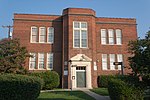Coca-Cola Bottling Company of Baltimore Building
Art Deco architecture in MarylandCoca-Cola buildings and structuresIndustrial buildings and structures on the National Register of Historic Places in BaltimoreIndustrial buildings completed in 1939

The Coca-Cola Bottling Company of Baltimore Building is a historic industrial building at 2525 Kirk Avenue in Baltimore, Maryland. The Moderne style building was built in 1939. The building includes hallmarks of the style, including rounded corners, horizontal bands of stonework, and stylized relief panels with renditions of the Coca-Cola Company logo.The building was listed on the National Register of Historic Places in 2013.
Excerpt from the Wikipedia article Coca-Cola Bottling Company of Baltimore Building (License: CC BY-SA 3.0, Authors, Images).Coca-Cola Bottling Company of Baltimore Building
Kirk Avenue, Baltimore
Geographical coordinates (GPS) Address External links Nearby Places Show on map
Geographical coordinates (GPS)
| Latitude | Longitude |
|---|---|
| N 39.318888888889 ° | E -76.600277777778 ° |
Address
The Monarch Academy Melnick Campus
Kirk Avenue 2525
21218 Baltimore
Maryland, United States
Open on Google Maps







